Your computer features top-rated components. This chapter provides details about your components, where they're located, and how they work.
HP ZBook 17 G5 Mobile Workstation - Components
Locating hardware
To find out what hardware is installed on your computer:
-
Type device manager in the taskbar search box, and then select the Device Manager app.A list displays all the devices installed on your computer.
For information about system hardware components and the system BIOS version number, press fn+esc (select products only).
Locating software
To find out what software is installed on your computer:
-
Select the Start button.‒ or –Right-click the Start button, and then select Apps and Features.
Right
Figure : Identifying the right-side components

|
Component
|
Description
|
||
|
(1)
|
Optical drive (select products only)
|
Depending on your computer model, reads an optical disc or reads and writes to an optical disc.
|
|
|
(2)
|
Optical drive eject button (select products only)
|
Releases the optical drive disc tray.
|
|
|
(3)
|

|
Audio-out (headphone)/Audio-in (microphone) combo jack
|
Connects optional powered stereo speakers, headphones, earbuds, a headset, or a television audio cable. Also connects an optional headset microphone. This jack does not support optional standalone microphones.
warning: note: |
|
(4)
|

|
HDMI port
|
Connects an optional video or audio device, such as a high-definition television, any compatible digital or audio component, or a high-speed High Definition Multimedia Interface (HDMI) device.
|
|
(5)
|

|
Dual-Mode DisplayPort
|
Connects an optional digital display device, such as a high-performance monitor or projector.
|
|
(6)
|
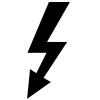
|
USB Type-C power connector and Thunderbolt port with HP Sleep and Charge
|
Connects an AC adapter that has a USB Type-C connector, supplying power to the computer and, if needed, charging the computer battery.
– and –
Connects and charges most USB devices that have a Type-C connector, such as a cell phone, camera, activity tracker, or smartwatch, and provides high-speed data transfer.
– and –
Connects a display device that has a USB Type-C connector, providing DisplayPort output.
note: note: |
|
(7)
|

|
Power connector
|
Connects an AC adapter.
|
|
(8)
|
Battery light
|
When AC power is connected:
When AC power is disconnected (battery not charging):
|
Left
Figure : Identifying the left-side components

|
Component
|
Description
|
||
|
(1)
|

|
Security cable slot
|
Attaches an optional security cable to the computer.
note: |
|
(2)
|

|
RJ-45 (network) jack/status lights
|
Connects a network cable.
|
|
(3)
|

|
USB SuperSpeed port with HP Sleep and Charge
|
Connects a USB device, provides high-speed data transfer, and even when the computer is off, charges most products such as a cell phone, camera, activity tracker, or smartwatch.
|
|
(4)
|

|
USB SuperSpeed ports (2)
|
Connects a USB device, such as a cell phone, camera, activity tracker, or smartwatch, and provides high-speed data transfer.
|
|
(5)
|

|
Memory card reader
|
Reads optional memory cards that store, manage, share, or access information.
To insert a card:
To remove a card:
|
|
(6)
|
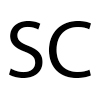
|
Smart card reader
|
Supports optional smart cards.
|
Display
note:Refer to the illustration that most closely matches your computer.
Figure : Identifying the display components
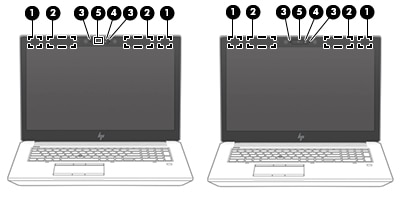
|
Component
|
Description
|
|
|
(1)
|
WLAN antennas*
|
Send and receive wireless signals to communicate with wireless local area networks (WLANs).
|
|
(2)
|
WWAN antennas*
|
Send and receive wireless signals to communicate with wireless wide area networks (WWANs).
|
|
(3)
|
Internal microphones
|
Record sound.
|
|
(4)
|
Camera light(s)
|
On: One or more cameras are in use.
|
|
(5)
|
Camera(s)
|
Allow(s) you to video chat, record video, and record still images.
note: |
|
*The antennas are not visible from the outside of the computer. For optimal transmission, keep the areas immediately around the antennas free from obstructions.
For wireless regulatory notices, see the section of the Regulatory, Safety, and Environmental Notices that applies to your country or region.
To access this guide:
‒ or –
|
Keyboard area
TouchPad
Figure : Identifying the TouchPad components

|
Component
|
Description
|
||
|
(1)
|
Pointing stick
|
Moves the pointer on the screen.
|
|
|
(2)
|
Left pointing stick button
|
Functions like the left button on an external mouse.
|
|
|
(3)
|
Center pointing stick button
|
Functions like the center button on an external mouse.
|
|
|
(4)
|
TouchPad zone
|
Reads your finger gestures to move the pointer or activate items on the screen.
|
|
|
(5)
|
Center pointing stick button
|
Functions like the center button on an external mouse.
|
|
|
(6)
|
Left TouchPad button
|
Functions like the left button on an external mouse.
|
|
|
(7)
|
Right TouchPad button
|
Functions like the right button on an external mouse.
|
|
|
(8)
|
Near Field Communications (NFC) tapping area and antenna*
|
Allows you to wirelessly share information when you tap it with an NFC-enabled device.
|
|
|
(9)
|
HP DreamColor sensor (select products only)
|
A colorimeter that brings integrated color calibration to your display. This built-in measurement instrument provides the ability to recalibrate a DreamColor color preset without the use of an external measurement instrument. To select a color preset or launch the calibration tool, select the HP DreamColor icon in the Windows taskbar. Make a selection from the menu and follow the on-screen instructions.
note: |
|
|
(10)
|
Right pointing stick button
|
Functions like the right button on an external mouse.
|
|
|
*The antenna is not visible from the outside of the computer. For optimal transmission, keep the area immediately around the antenna free from obstructions.
For wireless regulatory notices, see the section of the Regulatory, Safety, and Environmental Notices that applies to your country or region.
To access this guide:
‒ or –
|
Lights
Figure : Identifying the top lights

|
Component
|
Description
|
||
|
(1)
|

|
Power light
|
|
|
(2)
|
Caps lock light
|
On: Caps lock is on, which switches the key input to all capital letters.
|
|
|
(3)
|
Fn lock light
|
On: The fn key is locked. For more information, see Hot keys (select products only).
|
|
|
(4)
|
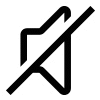
|
Mute light
|
|
|
(5)
|
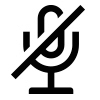
|
Microphone mute light
|
|
|
(6)
|

|
Wireless light
|
On: An integrated wireless device, such as a wireless local area network (WLAN) device and/or a Bluetooth® device, is on.
note: |
|
(7)
|

|
Sharing or presenting light
|
On: Sharing is on.
|
|
(8)
|

|
Call answer light
|
On: Call answer is on.
|
|
(9)
|

|
Call end light
|
On: Call end is on.
|
|
(10)
|

|
Num lk light
|
On: Num lock is on.
|
Buttons, speakers, and fingerprint reader
Figure : Identifying the top buttons

|
Component
|
Description
|
||
|
(1)
|

|
Power button
|
caution: If the computer has stopped responding and shutdown procedures are ineffective, press and hold the power button for at least 5 seconds to turn off the computer.
To learn more about your power settings, see your power options.
|
|
(2)
|
Speakers
|
Produce sound.
|
|
|
(3)
|
Fingerprint reader (select products only)
|
Allows a fingerprint logon to Windows, instead of a password logon.
|
Special keys
Figure : Identifying the top keys

|
Component
|
Description
|
||
|
(1)
|
esc key
|
Displays system information when pressed in combination with the fn key.
|
|
|
(2)
|
fn key
|
Executes frequently used system functions when pressed in combination with another key. Such key combinations are called hot keys.
|
|
|
(3)
|

|
Windows key
|
Opens the Start menu.
note: |
|
(4)
|
Action keys
|
Execute frequently used system functions.
See Action keys.
|
|
|
(5)
|
num lk key
|
Turns the embedded numeric keypad on and off when pressed in combination with the fn key.
– or –
Turns the embedded numeric keypad on and off.
– or –
Alternates between the navigational and numeric functions on the integrated numeric keypad.
|
|
|
(6)
|
Integrated numeric keypad
|
A separate keypad to the right of the alphabet keyboard. When num lk is pressed, the integrated keypad can be used like an external numeric keypad.
note: |
Action keys
An action key performs the function indicated by the icon on the key. To determine which keys are on your product, see Special keys.
-
To use an action key, press and hold the key.
|
Icon
|
Description
|
|
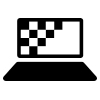
|
Helps prevent side-angle viewing from onlookers. If needed, decrease or increase brightness for well-lit or darker environments. Press the key again to turn off the privacy screen.
note: 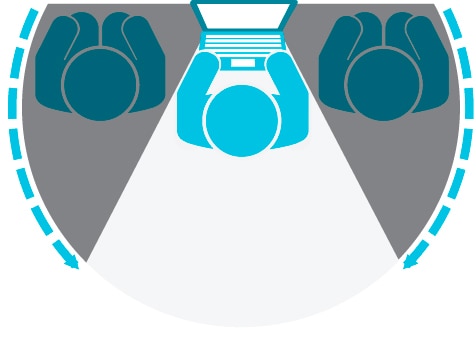
|
|

|
Decreases the screen brightness incrementally as long as you hold down the key.
|
|

|
Increases the screen brightness incrementally as long as you hold down the key.
|
|

|
Turns the keyboard backlight off or on.
note: |
|

|
Plays the previous track of an audio CD or the previous section of a DVD or a Blu-ray Disc (BD).
|
|

|
Starts, pauses, or resumes playback of an audio CD, a DVD, or a BD.
|
|

|
Plays the next track of an audio CD or the next section of a DVD or a BD.
|
|

|
Stops audio or video playback of a CD, a DVD, or a BD.
|
|

|
Decreases speaker volume incrementally while you hold down the key.
|
|
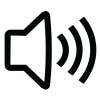
|
Increases speaker volume incrementally while you hold down the key.
|
|

|
Mutes the microphone.
|
|

|
Mutes or restores speaker sound.
|
|

|
Turns the wireless feature on or off.
note: |
|
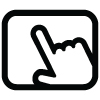
|
Turns the TouchPad and TouchPad light on and off.
|
|

|
Switches the screen image among display devices connected to the system. For example, if a monitor is connected to the computer, repeatedly pressing the key alternates the screen image from computer display to monitor display to simultaneous display on both the computer and the monitor.
|
|

|
Initiates Sleep, which saves your information in system memory. The display and other system components turn off and power is conserved. To exit Sleep, briefly press the power button.
caution: |
|

|
Provides quick access to your Skype for Business calendar.
note: |
|

|
Turns the screen sharing function on or off.
note: |
|
note: |
||
note: |
||
note:The action key feature is enabled at the factory. You can disable this feature by pressing and holding the fn key and the left shift key. The fn lock light will turn on. After you have disabled the action key feature, you can still perform each function by pressing the fn key in combination with the appropriate action key.
Hot keys (select products only)
A hot key is the combination of the fn key and another key.
To use a hot key:
-
Press the fn key, and then press one of the keys listed in the following table.
|
Key
|
Description
|
|
|
C
|
Turns on scroll lock.
|
|
|
E
|
Turns on the insert function.
| |
|
R
|
Breaks the operation.
| |
|
S
|
Sends a programing query.
| |
|
W
|
Pauses the operation.
| |
Bottom
Figure : Identifying the bottom components

|
Component
|
Description
|
||
|
(1)
|
Vent
|
Enables airflow to cool internal components.
note: |
|
|
(2)
|

|
Service door release latch with lock screw
|
Releases the service door.
|
Cover
Figure : Identifying the front components
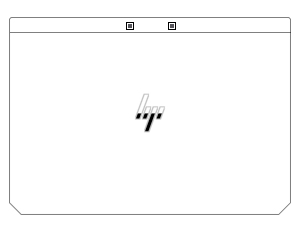
|
Component
|
Description
|
|
Internal microphones (2)
|
Record sound.
|
Rear
Figure : Identifying the rear components

|
Component
|
Description
|
||
|
Vents
|
Enable airflow to cool internal components.
note: |
||
Labels
The labels affixed to the computer provide information you may need when you troubleshoot system problems or travel internationally with the computer. Labels may be in paper form or imprinted on the product.
note:Check the following locations for the labels described in this section: the bottom of the computer, inside the battery bay, under the service door, on the back of the display, or on the bottom of a tablet kickstand.
-
Service label—Provides important information to identify your computer. When contacting support, you may be asked for the serial number, the product number, or the model number. Locate this information before you contact support.Your service label will resemble one of the examples shown below. Refer to the illustration that most closely matches the service label on your computer.Figure : Identifying the service label
 Component(1)HP product name(2)Model number(3)Product ID(4)Serial number(5)Warranty periodFigure : Identifying the service label
Component(1)HP product name(2)Model number(3)Product ID(4)Serial number(5)Warranty periodFigure : Identifying the service label Component(1)HP product name(2)Product ID(3)Serial number(4)Warranty period
Component(1)HP product name(2)Product ID(3)Serial number(4)Warranty period -
Regulatory label(s)—Provide(s) regulatory information about the computer.
-
Wireless certification label(s)—Provide(s) information about optional wireless devices and the approval markings for the countries or regions in which the devices have been approved for use.
Enter a topic to search our knowledge library
What can we help you with?
Need Help?
